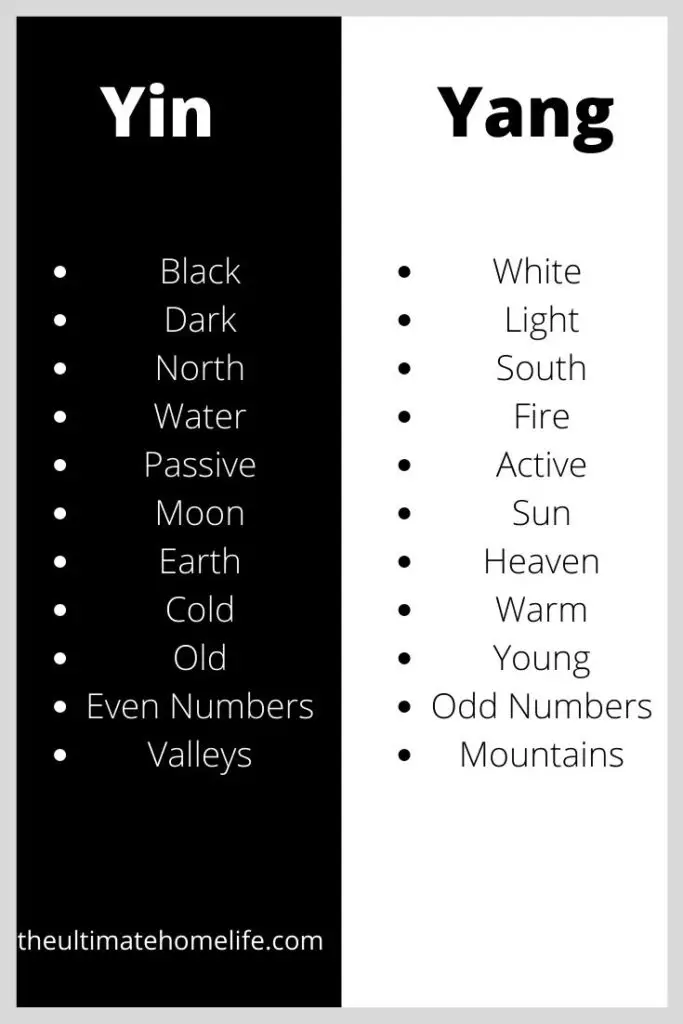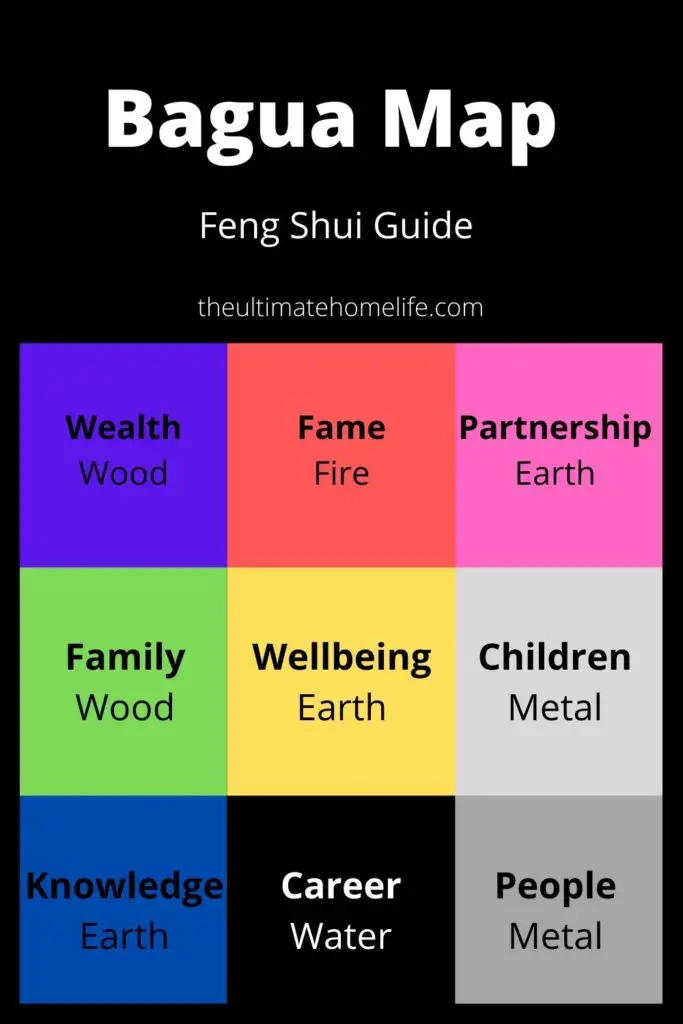Feng shui seems like an ancient practice that only a master could achieve. However, this is not true, there are basic Feng Shui guidelines. I put together a feng shui guide to help make it easier for you.
“There is no chance my home can have feng shui. I have three kids and 2 dogs my house is crazy town!”
- What is Feng Shui
- What is Ch’i
- History
- Branches of Feng Shui
- Understanding the elements
- Colors of Feng Shui
- Bagua Map
- Tricks to improve feng shui
What is Feng Shui?
Feng Shui actually means “wind and water”, It is the ancient Chinese art of placement. Feng shui has existed for thousands of years. It is used to facilitate the flow of the Ch’i in your home, garden, office, etc. The idea is that everything in your environment has energy. Feng shui allows people to influence how this energy interacts with them. For the most part, people talk about making sure their home has the right balance. The practice suggests that the right placement of objects will allow harmony. This harmony, or balance of energies, will translate into comfort and positivity in your home.
Feng shui is considered a pseudoscience. This is because it makes claims about how the world functions which cannot be tested by the scientific method. Deeper into this feng shui guide I talk about the history of feng shui.
What is Ch’i?
Ch’i (QI) is pronounced “chee” in English. Ch’i is the main principle of feng shui. According to the Institute of feng shui & Geopathology, Ch’i is the life force pervading everything. Similarly, Chinese medicine describes the Ch’i flow along the meridians within the body, feng shui depicts the flow of Ch’i in an environment such as a home or office.
Over time masters have studied how to use this energy and its benefits. Such as design entrances and gardens in a positive way. Ch’i is shown through form, shape, color, time, and direction. Manipulating these will change the way the energies of the world influence a person’s well-being.
History
The earliest known cultures that practiced feng shui were the Yangshao and Hongshan cultures. In the beginning, they used astronomy to find the connection between humans and the universe. Cosmography was found on a piece of jade at Hanshan and dated around 3000 BC. This cosmography looks very similar to the modern feng shui devices and formulas.
All capital cities of China followed the rules of feng shui starting with the Erlitou culture. There were even rules to follow in building manuals that included feng shui. Builders even went as far as to build graves and tombs following the guidelines of feng shui. The Guidelines of feng shui have been around for ages because they have benefited a lot of people. I put together this feng shui guide so that people can learn more about it.
There is also evidence that feng shui was practiced 5,500 years ago in India. India practiced similar principles of “Vastu Shasta” or “building science”. Some people believe that India practitioners traveled into China, leading to the Chinese adopting these practices.
Branches of Feng Shui
Traditional feng shui is an ancient system based on the observation of heavenly time and the earthly space. There are two main branches of feng shui the Form Branch and the Compass Branch.
Form Branch
The oldest branch of feng shui. In the beginning, the Form branch was used for the location and building of tombs. Soon this translated into homes and other buildings. “Form” speaks to the shape of the environment, rivers, buildings, mountains. The Form Branch takes main things into account such as the traditional five elements…
- Wood
- Fire
- Metal
- Earth
- Water
The Form Branch also considers the ying-yang concept and the five celestial animals (phoenix, green dragon, white tiger, black turtle, and the yellow snake).
Compass Branch
This branch is a collection of more recent Feng Shui techniques. Based on the eight cardinal directions (N, NE, E, SE, S, SW, W, NW), each direction having a unique Ch’i. This branch uses a Loupan, which is a Chinese magnetic compass. The Loupan is used to point the direction a structure or item is placed.
Understanding the elements
The idea of the element is that they always find balance. This theory calls for the universe to correct itself to find that balance in all things people, items, places. For example, your friend lets her fire burn and lies to you about something important. She will feel the effects of this fire by becoming emotionally burned out. To balance this she can extinguish this with water. Water can take the form of different things such as yoga, meditation, breathing techniques. Identifying these imbalances in your life can help you take control and balance it.
- Water: freedom, flow, and healing
- Fire: passion, romance, and success
- Metal: freshness, ease, clarity, and purity
- Wood: growth, expansion, vitality, and ultimate vision
- Earth: stability, protection, and nourishment
We need different amounts of these elements. These amounts depend on the environment and people. Make sure you use what’s best for your well being. It’s okay to be unsure of what you need and move things around. Here are some examples of decorating with the five elements.
Colors of Feng Shui
The colors in your home may be the reason your energy is off. Color is a very powerful tool. Choosing the wrong colors in your home can lead to depression, anxiety, and many other negative states of mind. Although, the benefit of balance is that everything can be countered. Use the colors of the five elements to your advantage and direct their power.
Elements in colors:
- Water: blue, black
- Fire: red, pink, orange
- Metal: gray, silver, white
- Wood: green, light green
- Earth: yellow, brown
Yin and Yang

You can use colors to direct Yin and Yang energies. Bright colors bring more Yang energy while darker colors bring more Yin energy. This can be a great way to separate rooms in the house. For example, darker colors can be used in the bedroom. Darker colors will result in a more calming, peaceful environment. This can help somebody relax after a long day. If you are decorating a room where a lot of activity happens you should use bright colors. The bright colors will give the room life and energy. Check out our chart and see if you are balancing your Yin and Yang.
Bagua Map
The Bagua Map is used to design your house. One method of using the map is called the front door method. During this method, the bottom of the map (knowledge, career, people) is the front entrance of your house.

If you would like to try this method you can align the map with your floor plan. This website will show you how you can align the nine sections of the Bagua map. These nine sections should all correspond to nine specific areas in your home.
If you live in a townhome or an apartment that is okay. You may notice that the feng shui Bagua map does not align with your space. This could be caused by irregular floor plans or protruding corners. Any floor plan can easily be aligned to balance the energies. Don’t worry, this is why there are many schools of thought. Every space is different and the perfect balance is not the same for individuals. Take your time and search for yours.
Tricks to improve feng shui
- Let the sunlight inside.
- Keep your spaces clean.
- Use the colors of the energies you want.
- Always add more plants. Here are some tips
- chairs, beds, sofas, and desks should be in a commanding position
- Keep mirrors clean.
- Sweep dust.
- Declutter.
- Make sure there is space between items.
- If there is not enough sunlight add light fixtures.
References
- “Feng Shui”. Institute of Feng Shui. Archived from the original on 2011-07-13. Retrieved 2011-05-15.



